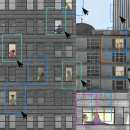Last Friday (19th of May) I visited a workshop hosted by my ITB colleagues for yet another follow-up activity of our EU-funded Learning Layers (LL) project. This time the German-funded DigiProB project had a workshop on preparing digital tools for continuing vocational training (CVT) in the construction sector. The participants (in addition to my ITB colleagues) were training managers from the training centre Bau-ABC, guest lecturers of their CVT schemes and the software developer supporting the project. I have had several encounters with the DigiProB project but this time I could witness that the participants were making progress in shaping digital tools to support their training activities. But let us first recapitulate what the project is about and what it tries to achieve.
The DigiProB project - Pedagogic challenges for CVT trainers and participants
The aim of the DigiProB project is to support the successive CVT schemes in construction sector (Vorarbeiter, Werkpolier, Geprüfte Polier) with digital tools. In this context the project has to cope with several pedagogic challenges:
a) Limited presence training time: The above mentioned CVT schemes are supported by very short course periods with face-to-face training. Most of the learning has to take place as self-organised learning alongside the work of the participants in construction sector. (These schemes are targeted as upgrading schemes for skilled workers in construction sector and prepare them for management responsibilities at different level.)
b) Subject-based curriculum framework vs. action-oriented learning goals: The main pedagogic challenge for developing the above mentioned CVT schemes was the tension between the subject-based curriculum contents and the action-oriented learning goals. Thus, the presence training is based on subject areas covered by guest lecturers that have been invited as subject specialists (e.g. for construction processes, construction techniques and personal management). Yet, a central role in the curriculum has been given for complex learning tasks and an integrative project report.
c) Providing support for self-organised learning by dispersed part-time lecturers: A further challenge was the fact that the lecturers were recruited individually to cover their subject areas during the course period. Thus, they did not have a collective responsibility on promoting the participants' learning beyond the course period. Yet, the lecturers were interested in providing further support inasmuch as they possibly could. Therefore, they were interested in working with digital tools for themselves and for their participants.
The DigiProB workshops - finding ways to provide support for integrative projects
During the last few months the DigiProB project has managed to establish a working group of active lecturers who serve as a pioneer group for developing integrative learning projects (and for introducing digital tools to support action-oriented learning in the CVT schemes). This working group has come together on monthly basis and now had its fifth meeting. I had visited their meeting only once - quite some time earlier - so I could now see the progress that the group had made. Below I try to sum up key achievements and working issues of this working group:
1. Working on two tracks to develop digital tools: Already at an early phase the working group took the course to two-track development of digital tools: a developmental platform for lecturers and a user-interface for participants. In this way the group avoided the risk of rushing to a 'one-size-fits-all' or 'one-design-fits-all' in introducing digital tools. For the moment the group is working primarily with the developmental platform to shape an integrative project that serves as a model for shaping further projects (and complex learning tasks). The shaping of user-interfaces can draw upon the progress with the work with this platform.
2. Shaping a model project to cover a wide range of content areas in an integrative vocational learning environment: Instead of using the developmental platform as a mere collector of training materials for different content areas the group has worked towards more integrative solutions. As a model project the group has chosen the construction of a motorway service area (Autobahn Raststätte) with different sub-projects (including construction of a kiosk-building with toilets, construction of special parking bay for trucks and lorries etc.). With such an overarching theme the lecturers were challenged to incorporate their training contents as contributions to sub-projects of the whole project. Moreover, the real challenges in coordinating such project became transparent in the mutual adjustment of the sub-projects. This led to cross-cutting questions like the following ones: "Can the construction of the kiosk-building be started before the groundwork for the parking bays has been completed?" "Can the building materials for the kiosk-building be stored properly at the construction site when the groundwork is still going on?"
3. Working towards project-related and integrative learning goals: In general the digital learning platforms tend to shape such learning environments with reference to (atomistic) content areas and (atomistic) learning goals. The working group took a course towards project-oriented and integrative learning goals. In this respect the lecturers maintained the curriculum document and its main learning areas (construction techniques, construction processes and personal management) as reference points. Yet, instead of proceeding to a patchwork-like layout of learning units, the group insisted on keeping the projects and sub-projects transparent on the platform. Furthermore, the group insisted on formulating such learning goals that link the above mentioned learning areas to each other.
Interim observations and reflections
I guess this is enough of the main themes of the workshop. In addition, some lecturers presented their own ideas on specific apps (to be found on the learning platform H5P) as support for individual learning. Others introduced ideas for serious games that could be used in the context of these training schemes. Altogether, these ideas envisaged to support the self-organised informal learning of CVT participants (before or after the limited course periods).
Furthermore, the process in the working group reminded me of the Multimedia training schemes that were implemented during the Learning Layers project in Bau-ABC. This working group was going through a similar learning process as the voluntary Bau-ABC trainers in the earlier phase of Multimedia training. However, the Bau-ABC trainers could focus on the project-based learning periods and vocational learning tasks in their trades - and use their blogs as repositories for training materials. They were not challenged to develop integrated projects. For the working group in the DigiProB project it was essential to bring different content areas together in an integrative project - in order to make progress with shaping digital tools for the CVT schemes. Just as it was in the Learning Layers project, it is important that this pioneering group makes progress with the model project - then to be able to share experiences and know-how with other colleagues.
Finally, the process reminds me also of the introduction of the Learning Toolbox in the apprentice training in Bau-ABC (as a user-interface for vocational learners to support work process-oriented learning). Just as in the Learning Layers project, the shaping of user-interfaces for the CVT participants needs to draw upon the pedagogic idea that are being developed by the DigiProB working group - then to be put into practice in the CVT schemes. From this perspective the earlier work in the shaping of the Learning Toolbox (for the apprentice training) serves as an advanced preparatory phase for the user-interfaces to be developed for the CVT participants.
- - -
I think this is enough of this DigiProB workshop. To me the participation as a visitor was a rich learning experience. And here I mean both regarding the development process of the DigiProB working group (as such) and the general picture of the learning Layers follow-up activities in construction sector (altogether). We (ITB and our partners) are building on the legacy of the Learning Layers project and its construction pilot. And we see new tasks and opportunities coming into picture.
More blogs to come ...








